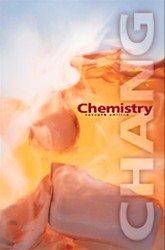|
 |  Chemistry, 7/e Raymond Chang,
Williams College
Transition Metal Chemistry and Coordination Compounds
Internet ExercisesTutorial on coordination chemistry
(http://wwwchem.uwimona.edu.jm:1104/courses/comligs.html)
- The University of the West Indies Mona Campus provides a tutorial on coordination
chemistry. At http://wwwchem.uwimona.edu.jm:1104/courses/comligs.html,
you will find 3-D structures of the complexes derived from common ligands
in Chime format. Answer the following questions based on the examples given.
- First, take a look at potassium tetrachloroferrate(III).
- Explain the III in potassium tetrachloroferrate(III).
- How many oxidation states can iron exhibit?
- What kind of an element is iron?
- Write the electron configuration for Fe.
- Explain why iron has variable oxidation states.
- Now, study the image of hexapyridineruthenium(II) chloride.
- Which is the metal atom?
- Which is the donor atom, and why is it referred to as the "donor"?
- What is the coordination number of this particular compound?
- Fill in the blank: This is an example of a _______dentate ligand.
- Describe the interaction between a metal atom and a ligand.
- What geometric arrangement does this compound exhibit?
|
 |  |  | stereoisomerism and structural isomerism
(http://wwwchem.uwimona.edu.jm:1104/courses/IC10Kiso.html)
- Other topics in coordination chemistry are stereoisomerism and structural
isomerism. Find out more about them at http://wwwchem.uwimona.edu.jm:1104/courses/IC10Kiso.html.
- Are the images of the cis- and trans- isomers of [Pt(NH3)2Cl2]
superimposable?
- What kind of isomers are they?
- Predict whether their melting points will be similar.
- Suppose your instructor handed you a mixture of two isomers unknown
to you, and the only information given to you was that the mixture was
an equimolar combination. Using a polarimeter, you studied the effects
it had on plane-polarized light, only to find that the two isomers showed
no rotation. A friend of yours tells you that from the results, it has
to be a racemic mixture. Is he right?
|
|
|



 2002 McGraw-Hill Higher Education
2002 McGraw-Hill Higher Education